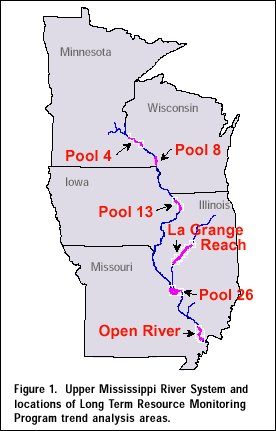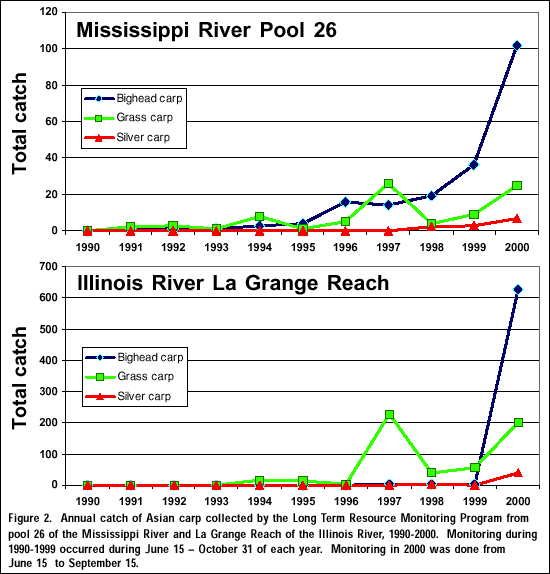|
PSR 2000-05 November 2000 Asian Carp Invasion of the Upper Mississippi River Systemby Todd M. Koel, Kevin S. Irons, and Eric Ratcliff |
|||||||||||||||||||||||||||||||||||||||||||||||||||||||||||||||||||||||||||||||||||||||||||||||||||||||||||||||||||||
|
Five species of Asian carp now occur in the contiguous United
States. These include grass carp (Ctenopharyngodon idella),
common carp (Cyprinus carpio), silver carp (Hypophthalmichthys
molotrix), bighead carp (H. nobilis) and black carp (Mylopharyngodon
piceus). Common carp, brought to the United States from Europe
in 1831, were soon propagated and distributed throughout waters
of the Upper Mississippi River System (UMRS).
Since 1990, standard and research monitoring (June 15–October 31 annually) by the LTRMP has documented variation and increases in total catch of three recently invading Asian carp species (Figure 2).The total catch of grass carp in 1997 was 26 from Pool 26 and 229 from the La Grange Reach. During June 15–September 15, 2000, we collected 25 grass carp from Pool 26 and 200 from the La Grange Reach. Fewer silver carp have been caught. The catch of silver carp increased from two in 1998 to seven in 2000 at Pool 26, and from two in 1998 to 39 in 2000 in the La Grange Reach. Bighead carp catches from Pool 26 steadily increased from one specimen per year in 1991– 1993 to 102 fish during our first two sampling efforts in 2000. In contrast, bighead carp catches from La Grange Reach remained relatively low (0–3 fish per year) through 1999 and then sharply increased to 627 in 2000. Most of these were young-of-the-year or juvenile fish, indicating that this species is reproducing in this reach of the UMRS. |
|||||||||||||||||||||||||||||||||||||||||||||||||||||||||||||||||||||||||||||||||||||||||||||||||||||||||||||||||||||
|
|||||||||||||||||||||||||||||||||||||||||||||||||||||||||||||||||||||||||||||||||||||||||||||||||||||||||||||||||||||
|
To some extent, we have also noticed species-specific habitat preferences. Catch of all species was highest in unstructured main channel borders (Table 1). However, grass carp catches were also relatively high along contiguous backwater shorelines. Bighead carp catches were also relatively high in contiguous backwater open habitats. |
|||||||||||||||||||||||||||||||||||||||||||||||||||||||||||||||||||||||||||||||||||||||||||||||||||||||||||||||||||||
|
|||||||||||||||||||||||||||||||||||||||||||||||||||||||||||||||||||||||||||||||||||||||||||||||||||||||||||||||||||||
|
Adverse Effects of Asian Carp Asian carp are becoming abundant and persistent residents of the lower reaches of the UMRS and the Illinois River. We may soon learn whether these large, prolific invaders affect other species and the environmental quality of this river system. On the basis of past experiences (e.g., with common carp), a failure to address the exotic species problem will likely result in more introductions and potential harmful effects to native biota. Monitoring by the LTRMP will be crucial for documenting forthcoming changes to our native riverine fishes because these recent Asian carp invaders are increasing in population and expanding in range. |
|||||||||||||||||||||||||||||||||||||||||||||||||||||||||||||||||||||||||||||||||||||||||||||||||||||||||||||||||||||
|
This report is a product of the Long Term Resource Monitoring Program for the Upper Mississippi River System. For further information, contact Kevin S. Irons Eric Ratcliff U.S. Geological Survey Project Status Reports (PSRs) are preliminary documents whose purpose is to provide information on scientific activities. Because PSRs are only subject to internal peer review, they may not be cited. Use of trade names does not imply U.S. Government endorsement of commercial products. All Project Status Reports are accessible through the Upper Midwest Environmental Sciences Center’s website at http://umesc.usgs.gov/reports_publications/psrs/umesc_psr.html |
|||||||||||||||||||||||||||||||||||||||||||||||||||||||||||||||||||||||||||||||||||||||||||||||||||||||||||||||||||||
Page Last Modified: April 17, 2018


 Grass
carp were imported from eastern Asia in 1963 to control submersed
aquatic vegetation in aquaculture ponds and were first documented
in the Mississippi River along Illinois in 1971. Silver carp and
bighead carp were imported from China in 1973 to improve water quality
of aquaculture ponds (initially in Arkansas). These species have
invaded our Midwestern rivers, through pond escapement or by deliberate
introductions and were first documented in the UMRS as early as
1982. Reproducing populations of these four species are now present
in the UMRS. Presently black carp, which are mollusk eaters, only
exist in aquaculture ponds of Arkansas and Mississippi.
Grass
carp were imported from eastern Asia in 1963 to control submersed
aquatic vegetation in aquaculture ponds and were first documented
in the Mississippi River along Illinois in 1971. Silver carp and
bighead carp were imported from China in 1973 to improve water quality
of aquaculture ponds (initially in Arkansas). These species have
invaded our Midwestern rivers, through pond escapement or by deliberate
introductions and were first documented in the UMRS as early as
1982. Reproducing populations of these four species are now present
in the UMRS. Presently black carp, which are mollusk eaters, only
exist in aquaculture ponds of Arkansas and Mississippi. 